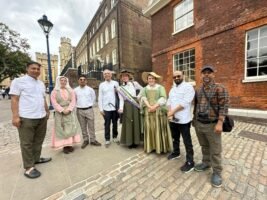
by Muhammed Shahed Rahman :
A historical fortress in Great Britain, the ‘Tower of London’ is not only a royal residence, but it is known to people for many other features. This historic building has been used as a storehouse of England’s royal crown, jewels, jewels and wealth, sometimes as an armoury, sometimes as a treasury, sometimes as a repository of documents, and again – in many other roles.
To some, it is best known for its gruesome prisons and torture chambers.
The Tower of London is an old medieval castle. In my view it is one of London’s iconic landmarks. One of the most historical with a bloody history, dating back almost a thousand years.

Located near Tower Bridge in London, England, this fort has many historical roles. It is a UNESCO World Heritage Site.
I didn’t know much about the Tower of London. To visit the Tower of London, I was invited by President of UK Bangla Reporters Unity (2023-2024 AD), researcher, journalist Agraj Pratim Ansar Ahmed Ullah bhai. He also collected the tickets on his own responsibility. This is an expression of His great sincerity towards us.
On Friday (August 30, 2024), Aslam toured the inner courtyard of the Tower of London under the leadership of Ansar Bhai after finishing Friday prayers. Community activist Jamal Ahmad Khan, SKM Ashraful Huda, Mirza Abul Kasem were also present.
I looked around the Tower of London inside and out. Ansar Bhai, a former journalist, told many unknown facts from the background of history.
Its earliest foundation, Janlam, was laid in 1066.
The White Tower, a keep in the innermost ward, is the oldest part of the castle and dates to the 1070s.
Every thing has a reason, a purpose.
There are many reasons behind the construction of the Tower of London.
I am presenting what I learned during the conversation with Ansar Bhai.
It is known from history – after entering the Tower of London, you will see the White Tower written in small letters.
The White Tower was built by William the Conqueror to secure his position against the fierce opposition of the conquered Saxons living in London. The keep served as a powerful and intimidating projection of Norman military power, although many comment that it was an angry symbol of oppression to the locals.
As mentioned earlier, the story of the construction of the Tower of London dates back to 1066.
The first structures to become the Tower of London were built by William the Conqueror after his conquest of England in 1066. Over the next 250 years, the fort went through several expansion phases under various English kings.
Now listen to the reasons for using the Tower of London:
The tower has been used and repurposed to serve many roles throughout its long history.
In its early history, it was a grand royal palace.
Later, it was used as a fortress and prison, a place of execution, an armory, a royal mint, and a menagerie (or zoo).
It is currently home to England’s priceless Crown Jewels, which take a lot of time to explore.
The Tower of London is home to 37 Yeoman Warders, a group of men and women drawn from the British military who must have recorded at least 22 years of active service. Nicknamed the ‘Beefeaters’, they have been guarding the Tower since Tudor times.
It is also home to the famous Tower Ravens, whose departure, according to legend, would herald the ‘fall of the kingdom’ if they ever flew.
Many are curious to know who owns the Tower of London?
The Tower of London is actually owned by the Crown Estate, which belongs to His Majesty the King by ‘right of the Crown’. It is not private property of the Crown and therefore cannot be sold.
Hear untold stories of this incredible British royal rarities and history, and if you have the time, visit the Tower of London once in a while.
Must-see highlights include the White Tower, the Jewel House, home of the priceless Crown Jewels, the Royal Mint, the ‘Bloody Tower’ and Tower Green, with many execution sites in the Tower and more.
There is also the opportunity to witness the ‘Ceremony of the Key’, a 700-year-old traditional ‘locking’ of the tower’s gates each evening.
Look like this with your inquisitive researcher mind
Step back almost 1,000 years to uncover the long, bloody history of one of London’s most famous landmarks. Discover how a royal residence became a notorious site of imprisonment and execution and get up close to the collection of priceless Crown Jewels. We finally came across the priceless crown, the Queen’s crown. Which has a lot of history.
Queen’s Crown or Kohinoor:
This Kohinoor is one of the most famous gems in the world, which was acquired by Britain from India during the colonial period.
The crown, made for Queen Elizabeth’s mother, is set with 2,800 precious stones, one of which is the brilliant 105-carat oval Kohinoor diamond.
Later, Queen Elizabeth II, the holder of that crown, ruled Britain for 70 years. He died on Thursday, September 8, 2022 at the age of 96.
Elizabeth II, full name Elizabeth Alexandra Mary; Born: 21st April 1926 — Died 8th September 2022.
She was Queen of the United Kingdom from 6 February 1952 to 8 September 2022.
This crown used to adorn the head of this reigning queen for a long time.
According to a report published in Time magazine, this Kohinoor was excavated in Andhra Pradesh, India during the 12th-14th century Kakatiya dynasty. It was then believed to be a total of 793 carats.
It first came into the hands of the Mughals in the 16th century. Then the Persian emperor Nadir Shah looted it. The diamond later passed into the hands of the Afghans.=
Indian Sikh Maharaj Ranjit Singh brought it back to India from Afghan leader Shah Shuja Durrani. From there it goes to the British.=
In the late 1840s, the East India Company seized the gem after forcing the 10-year-old Maharaja Dunjip Singh to surrender his lands and property.
The company then presented the diamond to Queen Victoria. Her husband Prince Albert cut it and placed it on the crowns of Queen Alexandra and Queen Mary. Subsequently, the diamond was placed in the crown of Queen Elizabeth II, mother of Elizabeth II, or the Queen Mother, in 1937.
The Queen Mother wore a portion of the crown at the coronation of her daughter Elizabeth II in 1953. The Kohinoor diamond has remained in the crown of the British Queen ever since.
Before entering the Tower of London, on the other side, there is a memorial plaque to those who died in World War I and World War II. Where there are thousands of names. People of various nationalities including the British gave their lives in these two wars. There are also names of Bengali heroes. Its number is not less.
Ansar Bhai said that the number of Bengali heroes who died fighting for the British in these two wars would be 15 to 16 thousand. A lot of research is needed in this research.
 Weekly Bangla Mirror | Bangla Mirror, Bangladeshi news in UK, bangla mirror news
Weekly Bangla Mirror | Bangla Mirror, Bangladeshi news in UK, bangla mirror news







